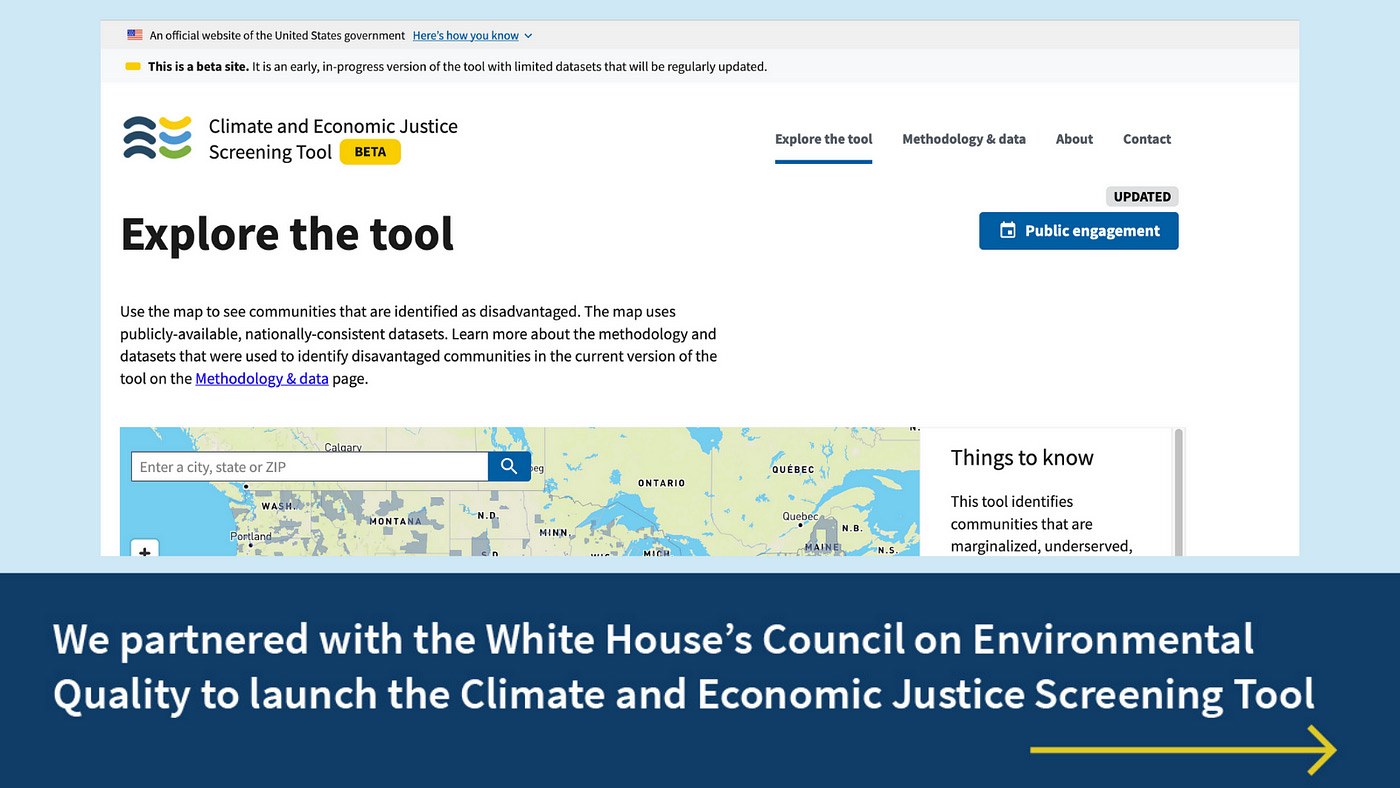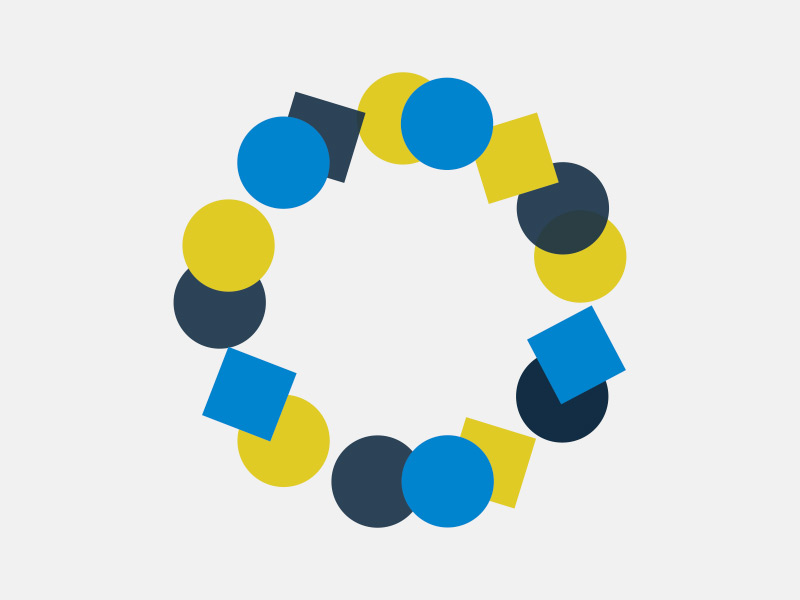Tackling the climate crisis with open source
Every one of us has the right to breathe clean air, drink clean water, eat safe, nourishing food, and live free from the threat of climate disasters wrecking our neighborhoods and livelihoods. But right now, many families and communities across the United States have to endure pollution in their air, water, food, and soil every day where they live and work.
The climate crisis is accelerating so much that the world’s best scientists keep telling us that we are “firmly on track toward an unlivable world.” The losses we’ve already experienced with worsening severe storms, extreme heat waves, drought, and wildfires have been exacerbated by racial injustice, economic injustice, and acutely unfair pollution burden.

At the U.S. Digital Service, some of our talented teammates are hard at work trying to reduce the injustices of the climate crisis.
The Justice40 Initiative is an ambitious and historic all-of-government commitment to environmental and climate justice. The Justice40 Initiative aims to deliver 40 percent of the overall benefits of hundreds of federal programs to disadvantaged communities that are marginalized, underserved, and overburdened by pollution. These covered programs have investments in one or more of the following seven areas:
- Climate change
- Clean energy and energy efficiency
- Clean transportation
- Affordable and sustainable housing
- Training and workforce development (related to climate, natural disasters, environment, clean energy, clean transportation, housing, water and wastewater infrastructure, and legacy pollution reduction, including in energy communities)
- Remediation and reduction of legacy pollution
- Critical clean water and waste infrastructure
One key question raised by the Justice40 policy is, which communities are defined as disadvantaged for the purposes of the Justice40 Initiative?
This is where we have been eager and committed to help. Together with the Council on Environmental Quality (CEQ), USDS is building the Climate and Economic Justice Screening Tool.

Using a methodology determined by CEQ, in collaboration with other federal agencies and departments, this tool collects data from 13 different sources to create a definition of disadvantaged communities for the purposes of the Justice40 Initiative. As required by the Executive Order on Tackling the Climate Crisis at Home and Abroad, the tool identifies communities that are “marginalized and overburdened by pollution and under-investment in housing, transportation, water and wastewater infrastructure, and healthcare.”
This screening tool is currently available in a public “beta” — or draft — version. CEQ is soliciting public feedback on the data and methodology used in the tool by email, survey, and the Federal Register, as well as through Tribal consultations and listening sessions. The tool will be regularly updated and refined based on feedback and as new datasets and research become available.
Importantly, the screening tool has been open source from the very start. Every piece of code used to load data, analyze data, identify disadvantaged communities, and visualize everything on a map is transparent and accessible to the public.
Because the tool is open source, anyone can view or reuse the tool’s code, or copy and modify it for their own purposes. The Administration of Children and Families, part of the U.S. Department of Health & Human Services, for example, has already built internal maps using the screening tool’s original source code. For this project, open source also means that any member of the public can contribute back to the tool.
The USDS team hosts the site on the U.S. Department of the Interior’s GeoPlatform.gov and built it using popular open source technologies such as Python, JavaScript, React, and MapLibre.
“We care about making our process open and enabling people in the community to contribute code, data, discussion, or bug reports,” said Shelby Switzer, an engineer at USDS and the screening tool’s original engineering lead.
To this end, Switzer and the team use an open source repository on Github, which is a popular source code management system for software developers. They also host regular gatherings on Zoom with community members who want to use or contribute to the tool, along with maintaining a Google group for the open source community.
Running this project from the start in as open and participatory a way as possible was important to the team as part of living environmental justice values.
The benefits of open source for government technology projects include cost savings, better products, and encouraging a standard of transparency for the people.
“Public digital services should be open, observable, and owned by the public,” said Switzer. “They are funded by taxpayer dollars so taxpayers should be able to see what is being built and use it themselves if they want.”
USDS advocates for this in our Digital Services Playbook, too, and making code open source unless there are extenuating circumstances is now federal policy.
The USDS Justice40 team believes that investing in the community participation side of this project is critical to support the project’s mission of advancing environmental justice.
“Environmental justice has a long history of participatory practices,” said Switzer, referencing the Jemez Principles for Democratic Organizing and the extensive ground-truthing with communities — which is a process to check the real-world accuracy of a project — that predecessor projects such as CalEnviroScreen engaged in.
Developing this tool with an open source community has been a labor of love, rewarding but also challenging. The team tried to reach out widely and openly to many environmental justice experts and researchers, but also acknowledges that some people were unintentionally left out. But this is a starting point, not a finish line. The tool will be updated regularly throughout its life. We’re grateful it is built on a transparent foundation.
This is just one of the many projects the U.S. Digital Service currently is working on to help direct the benefits of federal services to all those who need them. And we need your help. Come join us.
More posts
-
 Nov 10, 2022
Nov 10, 2022Meeting veterans where they are with accessible mobile tech
This Veterans Day, we’re honoring our current and former service members by highlighting a collaboration between the Department of Veterans Affairs and the U.S. Digital Service.
-
 Aug 15, 2022
Aug 15, 2022A quick guide to inclusive design
Designing for inclusion isn’t just about coding for accessibility or section 508 compliance, it’s about providing equitable and easy-to-use websites and services for diverse populations. Because good design is design that works for everyone.

